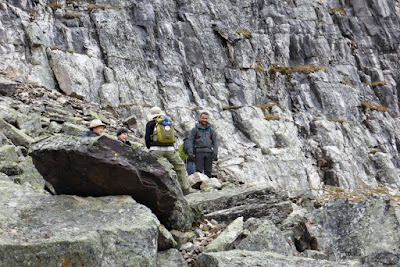Again, we had to sweep snow off the Corolla by hand. When we arrived at the trailhead there were only a couple of other cars, plus a camper, which was odd because camping is forbidden there. Much later we met the owner of the camper, Matt, and his dog; he was working for Parks Canada one week on and one week off. He had a permit.
From the parking area, everything lies ahead. Some destinations are further than others.
Comparing old and new maps, Joan and I could see that the Paradise Valley trail had been rerouted in places, and perhaps this explained why various sources listed the distance to Lake Annette between 5.7km and 7km. The trailhead sign listed 6.3km. Whatever. We were going to the lake.
We crunched uphill through crusty snow and past two very early trail intersections. Ours were the only footprints. Then Joan and I met two young men headed down carrying skis; they had almost certainly made an early start from the Paradise Valley campground, and would be the only people we'd see while outbound, although our hike's total would be fifteen plus one dog.
We paused where the Paradise Valley trail departed from the Lake Louise to Moraine Lake trail. The wide road towards Lake Louise is nominally a horse trail.
 |
| No bicycles! |
There was a bear warning.
Joan and I had put off visiting Moraine Lake for several years, because bears (a mom and two cubs) had taken up residence, and traveling in groups was mandatory. This year the ursine inhabitants hadn't been in evidence, and now groups were merely advisable. Plus winter was early this year. Still, we called out as we hiked on, alerting any bears that humans were coming.
The mountains played peek-a-boo with fog, drizzle, light snow, and times of no precipitation.
 |
| Crossing Paradise Creek |
Joan and I emerged onto the diminutive beach at Lake Annette.
Under these conditions there was no good place to sit for lunch, so we marched on, climbing westbound and higher on the ridge. The next destinations were some distance away.
The map indicated that eventually we would break out of the woods, which might, depending on the weather, offer us a viewpoint. That time seemed a long time coming. We did spot a woodpecker, an avian point of interest.
We decided to turn around, still in the woods, and finally encountered other hikers coming up the trail. After a brief repeat stop at Lake Annette
 |
| Scenic, but it didn't beckon us to linger. |
Joan and I encountered a snowman on one of the bridges crossing Paradise Creek.
 |
| Standing guard on the railing! |
On our return to Moraine Lake our first stop, and the first stop for many visitors, was the Rockpile, at the foot of the lake.
 |
| You can see why Moraine Lake has such a reputation for beauty. |
Visitors can rent a canoe as well as stroll along the lakeshore.
Later, it snowed some more during dinner.
After the evening meal we attended a talk by Joel of Great Divide Nature Interpretation. Great Divide does three talks per week at Moraine Lake; this was the only one we could catch. Tonight's topic was "The 7 Habits of Highly Effective Ungulates," and it was very engaging. They also guide hikes, but again, their schedule and ours didn't align.
Then it was off to bed, wondering how much more snow the morning would reveal.























































